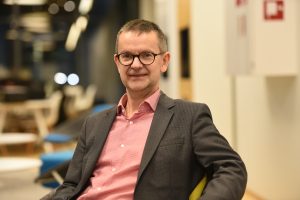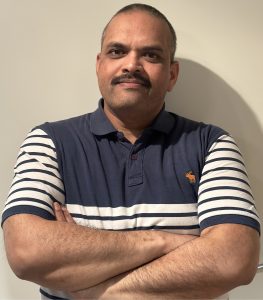Keynotes
 |
Title: From Reliability of Mobile Phone Packages to Advanced Solutions for Telecom Base Stations and Renewable Energy
Dr. Olli Salmela Reliability Engineering Manager at Nokia Bell Labs Adjunct Professor at Aalto University and University of Oulu, Finland Biography: Dr. Olli Salmela received his M.Sc., Lic.Tech. and D.Sc.(E.E.) degrees from Helsinki University of Technology in 1992, 1994, and 2005, respectively. He is currently a Reliability Engineering Manager at Nokia in Technology Leadership organization. Dr. Salmela is also an Adjunct Professor at Aalto University and at University of Oulu. His research interests include material technology, novel cooling methods, Virtual Power Plants, and reliability. He is the author or co-author of more than thirty scientific and technical papers, and a co-author of “Reliability in Microtechnology: Interconnects, Devices and Systems” by Springer. He has more than fifteen patents. Dr. Salmela is a Senior Member of IEEE. |
| In his keynote speech, Dr. Olli Salmela will cover a wide range of topics that he has studied during his career both at university and industry. Starting from conformal coating materials made of inherently conductive polymers and closing to his current areas of interest related to technologies that enable sustainability improvements at electronics industry.
During his career, Dr. Salmela has supported both mobile phone and telecom infrastructure products. Early in his career, he studied the reliability of MCM-L technology that was used in the world’s first smart phone, Nokia Communicator. MCM-L proved to be rugged technology that enabled significantly higher packaging density. While working at Nokia Telecommunications, MCM-C technology was taken into use for critical RF components. MCM-C could embed high-Q passive components in the substrate. MCM-C technology was productized in early WCDMA radio products. Due to RoHS directive, Nokia proactively started using lead-free solder materials, although at the time telecom infrastructure was still exempted from the regulation. In the studies Dr. Salmela performed, it was proven that lead-free solder materials can safely be used even in case of telecom products, where long lifetime is expected. The fatigue models Dr. Salmela created are still in active use both in the industry and in the academia. In the end of his speech, Dr. Salmela will cover Liquid Cooling and Virtual Power Plant (VPP) technologies that his team has created and that are currently commercially available. Liquid Cooling can reduce the base station’s CO2 footprint by 80% and VPP is an enabling technology for wider use of renewable energy, such as solar and wind power. |
|
 |
Title: The European Chips Act: Opportunities and Challenges
Ralph W. Bernstein (PhD) Senior Business Developer, SINTEF Digital, Norway Biography: Dr. Ralph W. Bernstein is Senior Business Developer at SINTEF Digital, and has more than twenty years of management experience, including technology companies, commercialization, startups, research, and academia. |
| Digital technologies play a key role in achieving a sustainable, fair, and competitive future; often referred to as the green and digital, twin, transition. In this context the EU Commissioner for the Internal Market, Thierry Breton, Commissioner for Internal highlights the importance of chip technologies: “Without chips, no digital transition, no green transition, no technological leadership.” As a response to the chip crisis during the Covid pandemic, and considerable geopolitical uncertainty, the European Commission has, hence, launched The European Chips Act. The Chips Act is a comprehensive initiative aimed at strengthening Europe’s competitiveness as well as secure supply of chip technologies and applications. The European Chips Act is not only about building new chip factories to ensure security of supply. It will also be an essential contribution to digitalization and thus, the green transition. To achieve this, it is crucial to strengthen Europe’s research and technology leadership and to address the skills shortage. Research and Technology organizations (RTOs) will consequently be key players in establishing important new capacities like pilot lines, competence centers, as well R&D and innovation capability in the field of new chip technologies and applications. There are several ongoing initiatives both on networks of new pilot lines and competence centers that will require substantial funding support both nationally and through the EU system. Such programs call for coordinated actions between RTOs, academia, industry, and governments. | |
 |
Title: Textile-based Wearable Antennas and Interconnections in Body-centric Wireless Systems
Leena Ukkonen Professor at Faculty of Medicine and Health Technology, Tampere University Biography: Leena Ukkonen is a Professor at Faculty of Medicine and Health Technology, Tampere University. Her scientific research is focused on wireless implantable biomedical sensors and wireless communication and power transfer in human body environment. She has an extensive, 20-year research background on antennas and wireless power transfer in harsh environments, novel electronics materials and manufacturing methods, implantable antennas, wearable and textile-based antennas, computational electromagnetic modeling, and wireless implantable biomedical sensors. Especially, her Wireless Identification and Sensing Systems (WISE) research lab has expertise on brain implantable wireless sensors and antennas for wireless brain-machine interfaces. In addition to her scientific research activities, she served in several peer-recognized commissions of trust in the scientific community. Currently, she is the Chair of the Scientific Council for Natural Sciences and Engineering at Research Council of Finland. |
| In this presentation, we will focus on different aspects of body-centric wireless communication utilizing textile-based antennas and interconnections. We will present different antenna topologies for data and power transfer through tissue, in vitro and in vivo studies on implantable intracranial pressure (ICP) sensors and give insight and analysis on wireless link reliability in tissue environment when textile-based antennas are used. We will also present radio frequency identification (RFID)-based implant platform and communication method. Moreover, we will focus on differences and challenges of in vivo environment compared to laboratory phantoms and tissue models. | |
 |
Title: A Fully Additive Manufacturing Approach for the Fabrication of Interconnects, Onboard, and Embedded Passives for HDI-Printed Circuit Boards
Dr. Shailesh Singh Chouhan Researcher, Luleå University of Technology, Sweden
|
| High-density interconnect (HDI) printed circuit board (PCB) technology is evolving to further enable the miniaturization and enhanced functionality of electronics, such as smartphones, tablet computers, and wearable devices. Therefore, interconnect lines and spaces (L/S) comparable to those in integrated circuits are needed to increase the layers without increasing the size, weight, or volume of the PCB. In this keynote, we will focus on the development of a fully additive fabrication technique that is precise, uniform, cost-effective, and environmentally friendly for creating next-generation, miniaturized HDI PCBs. This method, called Sequential Build-Up Covalent Bonded Metallization (SBUCBM), has the capability to fabricate miniaturized interconnects. Dr. Shailesh Singh Chouhan, a mixed-signal circuit designer, is currently working towards the development of the SBUCBM with his colleagues. | |


